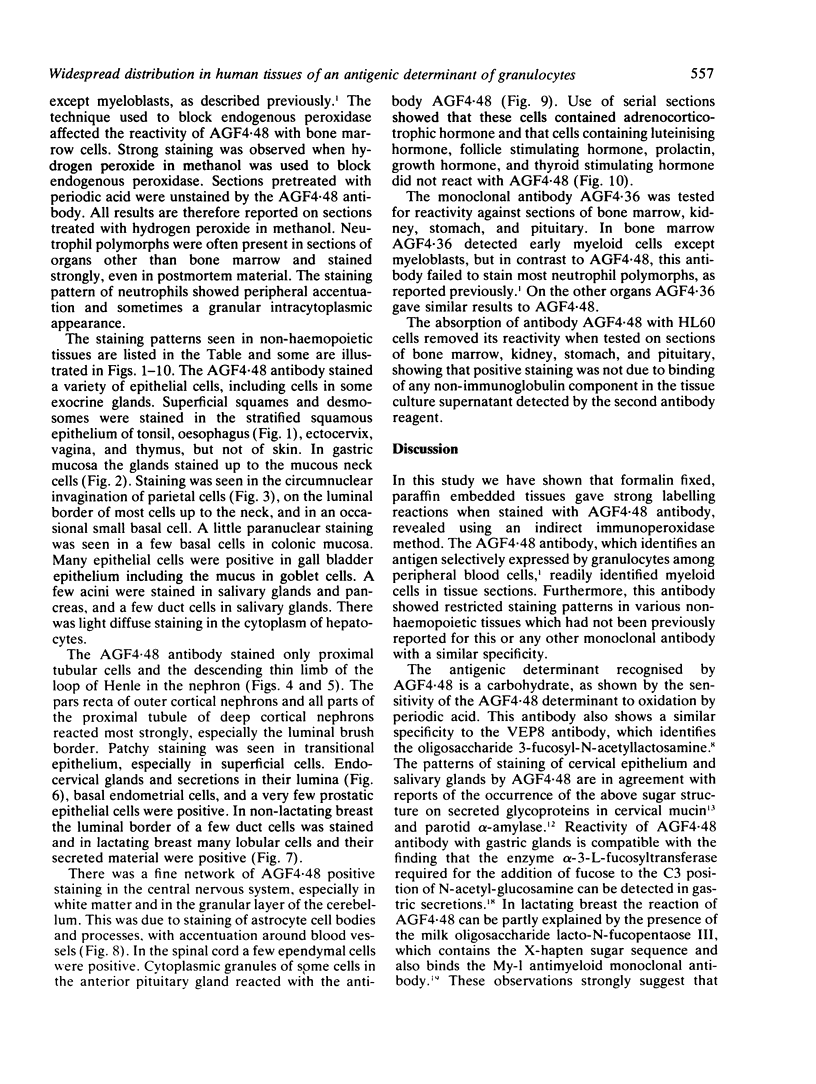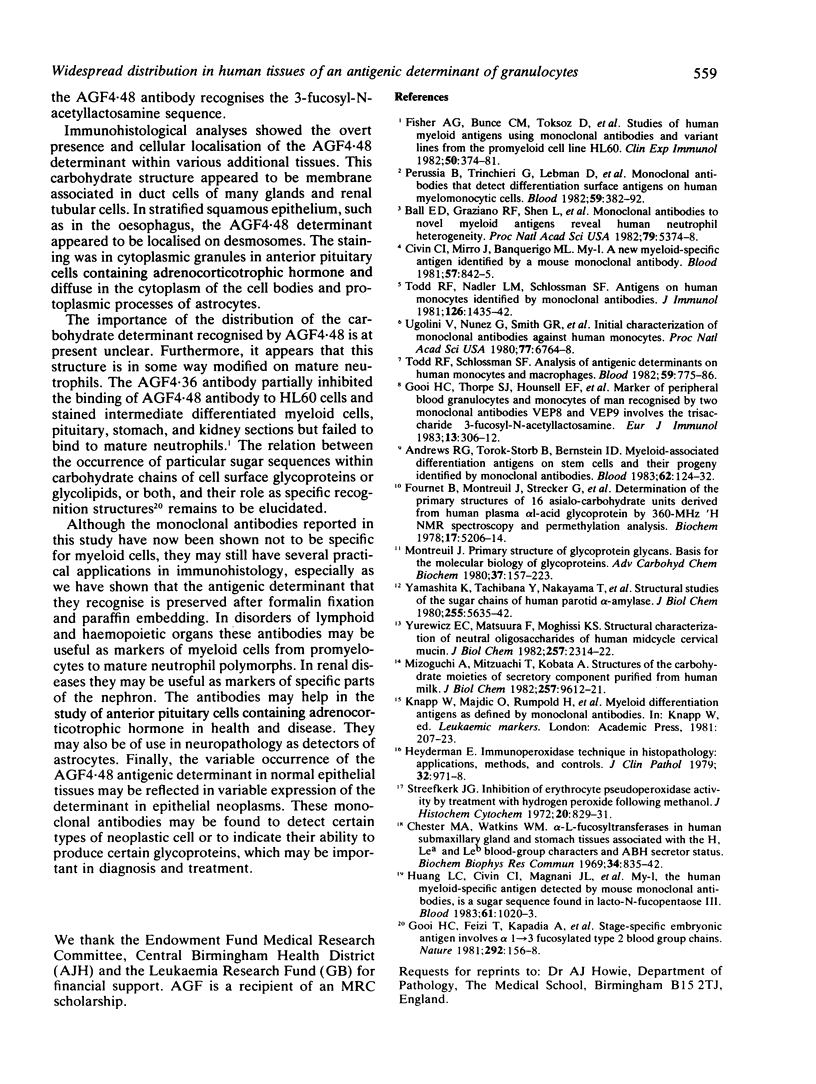Abstract
The monoclonal antibodies AGF4 .48 and AGF4 .36 have previously been shown to distinguish human granulocyte lineage cells from other peripheral blood and bone marrow cells. The AGF4 .48 antigen, which is carbohydrate in nature, together with similar antigens described by numerous investigators have been considered specific differentiation antigens of myeloid cells. In immunohistological studies of a wide range of normal tissues, the AGF4 .48 antibody selectively stained cells in several apparently unrelated tissues. These included proximal tubules and descending thin limbs in the kidney, parietal cells in the stomach, a variety of other epithelial cells, astrocytes in the brain, and cells in the anterior pituitary containing adrenocorticotrophic hormone. The AGF4 .36 antibody gave similar results on kidney, stomach and pituitary. These findings emphasise the importance of assessing the binding of monoclonal antibodies, which appear unique in their reactivity with blood cells, to non-haemopoietic tissues before assigning specificity to reagents. The distribution of cells expressing the AGF4 .48 and AGF4 .36 antigen correlates with the occurrence of the 3-fucosyl-N-acetyllactosamine carbohydrate structure in various secreted glycoproteins.
Full text
PDF




Images in this article
Selected References
These references are in PubMed. This may not be the complete list of references from this article.
- Andrews R. G., Torok-Storb B., Bernstein I. D. Myeloid-associated differentiation antigens on stem cells and their progeny identified by monoclonal antibodies. Blood. 1983 Jul;62(1):124–132. [PubMed] [Google Scholar]
- Ball E. D., Graziano R. F., Shen L., Fanger M. W. Monoclonal antibodies to novel myeloid antigens reveal human neutrophil heterogeneity. Proc Natl Acad Sci U S A. 1982 Sep;79(17):5374–5378. doi: 10.1073/pnas.79.17.5374. [DOI] [PMC free article] [PubMed] [Google Scholar]
- Chester M. A., Watkins W. M. Alpha-L-fucosyltransferases in human submaxillary gland and stomach tissues associated with the H, Lea and Leb blood-group characters and ABH secretor status. Biochem Biophys Res Commun. 1969 Mar 31;34(6):835–842. doi: 10.1016/0006-291x(69)90256-3. [DOI] [PubMed] [Google Scholar]
- Civin C. I., Mirro J., Banquerigo M. L. My-1, new myeloid-specific antigen identified by a mouse monoclonal antibody. Blood. 1981 May;57(5):842–845. [PubMed] [Google Scholar]
- Fisher A. G., Bunce C. M., Toksoz D., Stone P. C., Brown G. Studies of human myeloid antigens using monoclonal antibodies and variant lines from the promyeloid cell line HL60. Clin Exp Immunol. 1982 Nov;50(2):374–381. [PMC free article] [PubMed] [Google Scholar]
- Fournet B., Montreuil J., Strecker G., Dorland L., Haverkamp J., Vliegenthart F. G., Binette J. P., Schmid K. Determination of the primary structures of 16 asialo-carbohydrate units derived from human plasma alpha 1-acid glycoprotein by 360-MHZ 1H NMR spectroscopy and permethylation analysis. Biochemistry. 1978 Nov 28;17(24):5206–5214. doi: 10.1021/bi00617a021. [DOI] [PubMed] [Google Scholar]
- Gooi H. C., Feizi T., Kapadia A., Knowles B. B., Solter D., Evans M. J. Stage-specific embryonic antigen involves alpha 1 goes to 3 fucosylated type 2 blood group chains. Nature. 1981 Jul 9;292(5819):156–158. doi: 10.1038/292156a0. [DOI] [PubMed] [Google Scholar]
- Gooi H. C., Thorpe S. J., Hounsell E. F., Rumpold H., Kraft D., Förster O., Feizi T. Marker of peripheral blood granulocytes and monocytes of man recognized by two monoclonal antibodies VEP8 and VEP9 involves the trisaccharide 3-fucosyl-N-acetyllactosamine. Eur J Immunol. 1983 Apr;13(4):306–312. doi: 10.1002/eji.1830130407. [DOI] [PubMed] [Google Scholar]
- Heyderman E. Immunoperoxidase technique in histopathology: applications, methods, and controls. J Clin Pathol. 1979 Oct;32(10):971–978. doi: 10.1136/jcp.32.10.971. [DOI] [PMC free article] [PubMed] [Google Scholar]
- Huang L. C., Civin C. I., Magnani J. L., Shaper J. H., Ginsburg V. My-1, the human myeloid-specific antigen detected by mouse monoclonal antibodies, is a sugar sequence found in lacto-N-fucopentaose III. Blood. 1983 May;61(5):1020–1023. [PubMed] [Google Scholar]
- Mizoguchi A., Mizuochi T., Kobata A. Structures of the carbohydrate moieties of secretory component purified from human milk. J Biol Chem. 1982 Aug 25;257(16):9612–9621. [PubMed] [Google Scholar]
- Montreuil J. Primary structure of glycoprotein glycans: basis for the molecular biology of glycoproteins. Adv Carbohydr Chem Biochem. 1980;37:157–223. doi: 10.1016/s0065-2318(08)60021-9. [DOI] [PubMed] [Google Scholar]
- Perussia B., Trinchieri G., Lebman D., Jankiewicz J., Lange B., Rovera G. Monoclonal antibodies that detect differentiation surface antigens on human myelomonocytic cells. Blood. 1982 Feb;59(2):382–392. [PubMed] [Google Scholar]
- Streefkerk J. G. Inhibition of erythrocyte pseudoperoxidase activity by treatment with hydrogen peroxide following methanol. J Histochem Cytochem. 1972 Oct;20(10):829–831. doi: 10.1177/20.10.829. [DOI] [PubMed] [Google Scholar]
- Todd R. F., 3rd, Nadler L. M., Schlossman S. F. Antigens on human monocytes identified by monoclonal antibodies. J Immunol. 1981 Apr;126(4):1435–1442. [PubMed] [Google Scholar]
- Todd R. F., 3rd, Schlossman S. F. Analysis of antigenic determinants on human monocytes and macrophages. Blood. 1982 Apr;59(4):775–786. [PubMed] [Google Scholar]
- Ugolini V., Nunez G., Smith R. G., Stastny P., Capra J. D. Initial characterization of monoclonal antibodies against human monocytes. Proc Natl Acad Sci U S A. 1980 Nov;77(11):6764–6768. doi: 10.1073/pnas.77.11.6764. [DOI] [PMC free article] [PubMed] [Google Scholar]
- Yamashita K., Tachibana Y., Nakayama T., Kitamura M., Endo Y., Kobata A. Structural studies of the sugar chains of human parotid alpha-amylase. J Biol Chem. 1980 Jun 25;255(12):5635–5642. [PubMed] [Google Scholar]
- Yurewicz E. C., Matsuura F., Moghissi K. S. Structural characterization of neutral oligosaccharides of human midcycle cervical mucin. J Biol Chem. 1982 Mar 10;257(5):2314–2322. [PubMed] [Google Scholar]




